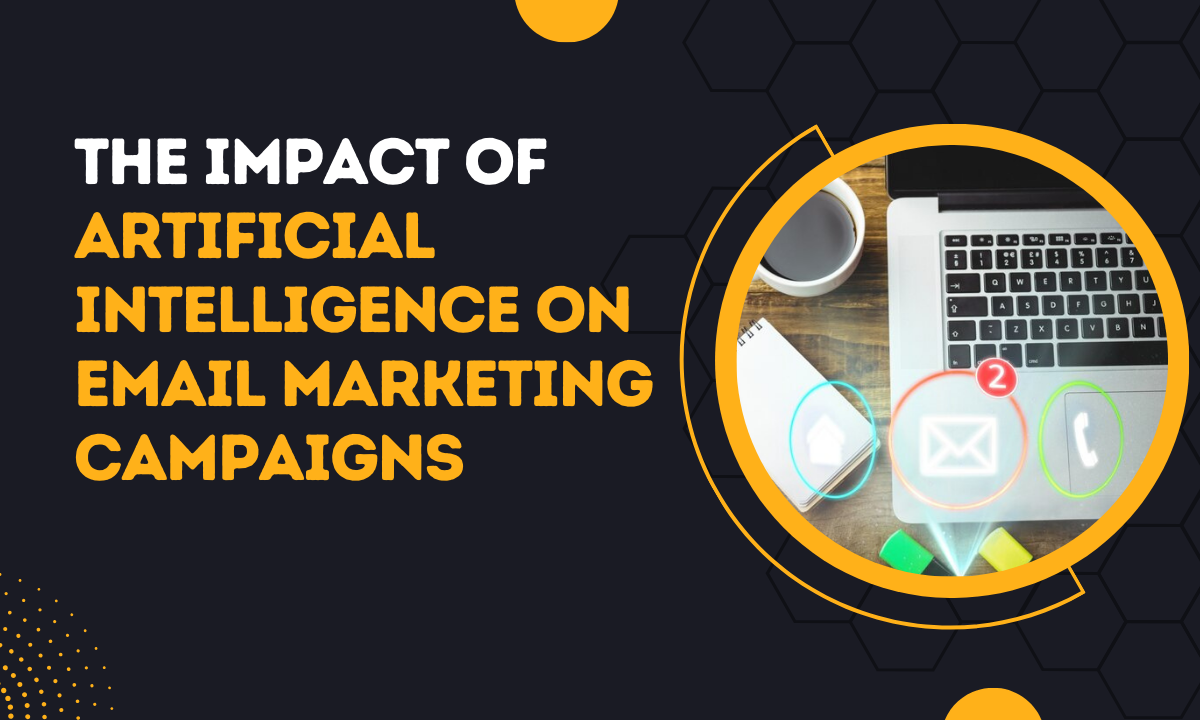The Impact of Artificial Intelligence on Email Marketing Campaigns
In the ever-evolving landscape of the digital age, AI in email marketing has begun to alter the face of email content, quietly influencing our choices and preferences.
Did you know that, on average, for every dollar spent on email marketing, you can expect an impressive return of $42? Yep, you heard it right – talk about a marketing powerhouse!
Now, get ready for the real game-changer – Artificial Intelligence, or as we like to call it, the secret sauce of innovation.
AI is not just a buzzword; it’s a revolutionary force reshaping industries faster than you can say “automation.”
From healthcare to finance, and now, drumroll please, to the heart of our conversation – email marketing.
In this blog post, we’re on a mission to explore how AI is sprinkling its magic dust on email marketing campaigns, transforming them from static messages to dynamic, personalized experiences.
So, get ready to witness the fusion of creativity and data, where every click, open, and scroll is a step towards marketing nirvana.
1. Evolution of Email Marketing
Now that we’ve set the stage, let’s turn the pages of history and explore the fascinating Evolution of Email Marketing.
1.1 Traditional Methods Unveiled
In the not-so-distant past, email marketing was akin to a digital town crier, broadcasting messages to the masses.
Basic, yet effective, marketers relied on sending bulk emails to their entire subscriber list, hoping something would stick. Remember those generic “one-size-fits-all” emails? Yeah, we shudder too!
But here’s the kicker – even with the simplicity, email marketing showed its prowess.
It became a direct line of communication, offering a cost-effective way to reach a broad audience. However, as technology sprinted ahead, traditional methods started to show their age.
1.2 Challenges in the Old World
Picture this: Marketers tirelessly crafting emails, sending them off into the digital abyss, and crossing their fingers for engagement.
Sound familiar?
Well, that was the reality in the absence of advanced technologies. Challenges and limitations were aplenty.
- Spray-and-Pray Approach: Sending generic messages to everyone, hoping for conversions. Spoiler: It didn’t always work.
- Limited Personalization: Personalizing emails beyond “Hello [First Name]” was a Herculean task, leaving subscribers feeling like mere numbers.
- Manual Analytics: Marketers relied on manual data analysis, drowning in spreadsheets to decipher email performance.
- Overwhelmed Subscribers: Inundated inboxes led to content fatigue, with subscribers either ignoring or, worse, hitting the dreaded unsubscribe button.
1.3 The Craving for Innovation
Enter the stage: the desperate need for innovation. Marketers hungered for tools to make their lives easier and emails more impactful.
It wasn’t just about reaching the inbox; it was about making a connection and crafting experiences that resonated.
With consumer expectations evolving, the need for a dynamic, personalized approach became undeniable.
The drumbeat for innovation grew louder as marketers yearned for solutions to break free from the shackles of generic campaigns.
2. Introduction to Artificial Intelligence in Email Marketing
Now that we’ve journeyed through the annals of email marketing history, let’s fast forward to the present and unravel the marvels of Artificial Intelligence in our favorite realm – Email Marketing!
2.1 Decoding Artificial Intelligence
Artificial Intelligence, or AI, isn’t just a sci-fi dream anymore; it’s the powerhouse behind the tech revolution.
In simple terms, AI refers to machines or computer systems that mimic human intelligence, learning from data, adapting to tasks, and making decisions.
It’s the magic that turns zeros and ones into intelligent, problem-solving wizards.
But hold on, AI isn’t confined to futuristic robots or blockbuster movies.
Its influence spans far and wide, infiltrating various fields like healthcare, finance, and, you guessed it, our beloved digital marketing space.
2.2 AI’s Expansive Reach
In healthcare, AI analyzes medical data to predict diseases. In finance, it optimizes trading strategies and detects fraudulent activities.
Now, let’s shine the spotlight on how AI steps onto the email marketing stage, turning campaigns into finely tuned orchestras of engagement.
2.3 AI’s Grand Entrance into Email Marketing
Imagine having a virtual marketing assistant who not only understands your audience but also predicts their next move.
That’s the magic AI brings to email marketing. It’s not just about sending emails; it’s about sending the right email to the right person at the right time.
AI’s integration into email marketing is a game-changer. It transforms static campaigns into dynamic, personalized experiences that resonate with each subscriber.
The era of “Dear [First Name]” is making way for hyper-personalization driven by data and insights.
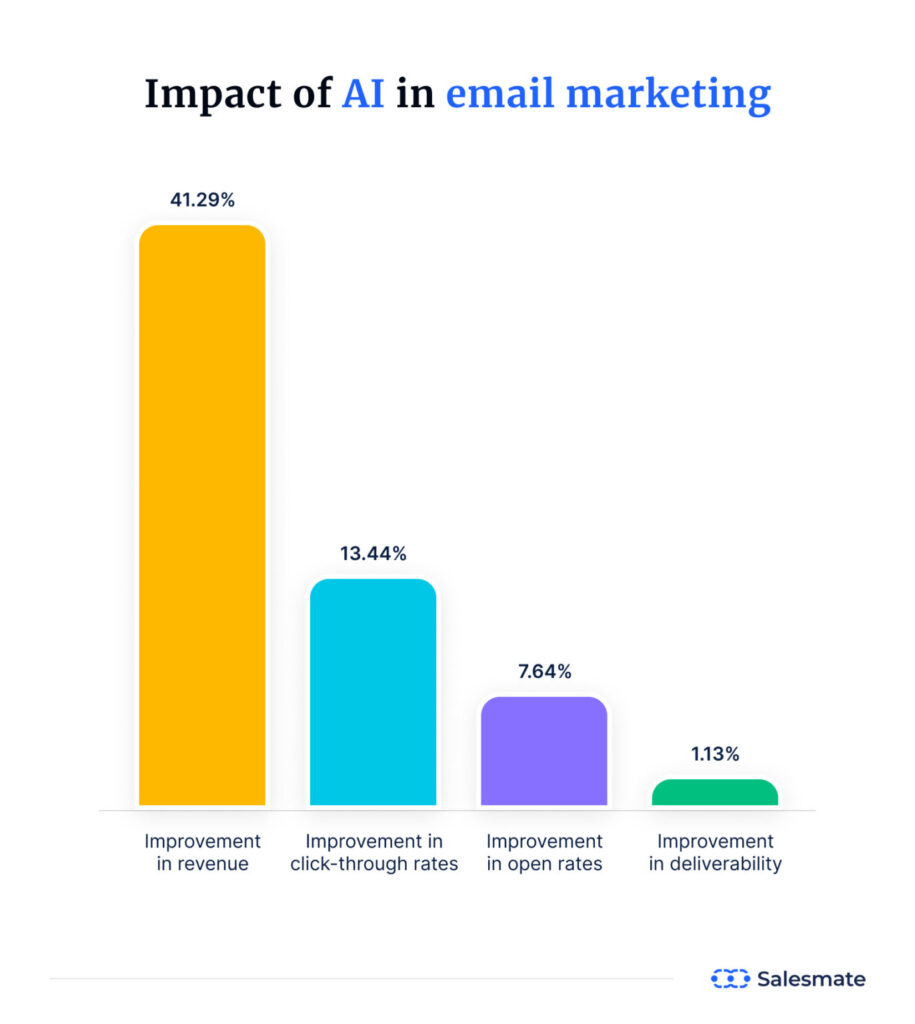
2.4 Types of AI in Email Marketing
Machine Learning (ML): This is the brainpower behind predictive analytics. ML algorithms analyze vast amounts of data to predict future outcomes.
In email marketing, it means foreseeing what content a subscriber is likely to engage with.
- Natural Language Processing (NLP): Ever received an email that felt like it was written just for you? NLP makes it happen. It enables machines to understand and generate human-like text, enhancing the conversational aspect of email content.
- Predictive Analytics: The crystal ball of email marketing. Predictive analytics, powered by AI, forecasts customer behavior, helping marketers anticipate preferences and tailor campaigns accordingly.
As we delve deeper, we’ll witness how these AI champions collaborate to revolutionize the way marketers connect with their audience.
3. Personalization and Targeting
Now, we’ve stepped into the world of Artificial Intelligence, and it’s time to witness the transformative magic it weaves in the realms of Personalization and Targeting within our beloved email campaigns.
3.1 The Power of Personalization
Gone are the days of generic greetings and one-size-fits-all content.
Do you know that email subject lines that are personalized have a 50% more open rate?
Enter AI-powered personalization, where each email becomes a bespoke experience for the recipient.
It’s like having a personal shopper for your inbox, curating content tailored to your preferences.
3.2 AI’s Personalization Wizardry
Picture this scenario: You open your inbox, and voila! An email appears, addressing you by name, recommending products based on your previous purchases, and even suggesting content that aligns with your interests. That’s the beauty of AI-enabled personalization.
AI algorithms analyze a treasure trove of data – from past interactions to browsing behavior – to create a detailed profile of each subscriber.
It allows marketers to serve up content that resonates, creating a sense of connection and relevance.
It’s the difference between an email and a personalized conversation.
Read our quick tips on connecting with your audience through emails.
3.3 Dynamic Email Campaigns Unleashed
AI doesn’t stop at static emails; it’s the force behind dynamic campaigns that evolve based on user behavior.
Imagine receiving an email that adapts in real-time, showcasing different products or messages depending on how you interact with it.
That’s the dynamism AI brings to the table.
3.4. Importance of Targeted Marketing
Now, let’s talk about the crucial role of targeted marketing.
AI doesn’t just guess what might work; it decodes user behavior patterns, allowing marketers to send the right message to the right audience.
Targeted marketing is precision-guided – no more shooting in the dark and hoping for the best.
3.5 AI’s Analytical Prowess
AI algorithms, armed with machine learning capabilities, sift through mountains of data to uncover patterns and trends.
They understand when a subscriber opens emails, what content they engage with, and when they’re most likely to make a purchase.
It’s like having a crystal ball that predicts subscriber preferences.
Learn more about the key indicators you need to monitor to measure the success of your email marketing strategies.
By leveraging AI-driven insights, marketers can craft campaigns that not only grab attention but also drive meaningful interactions. It’s about delivering value to the audience, fostering engagement, and, ultimately, building long-lasting customer relationships.
4. Automation and Efficiency
You’ve witnessed the enchanting power of AI in personalization, and now it’s time to unveil the next act in our marketing saga: Automation and Efficiency.
Get ready to see how AI takes the reins, transforming mundane tasks into a symphony of streamlined processes.
4.1 Automating the Email Marketing Symphony
Imagine having a tireless assistant who tirelessly handles repetitive tasks, allowing you to focus on the creative and strategic aspects of your campaigns. Enter AI-driven automation, the unsung hero of efficiency in email marketing.
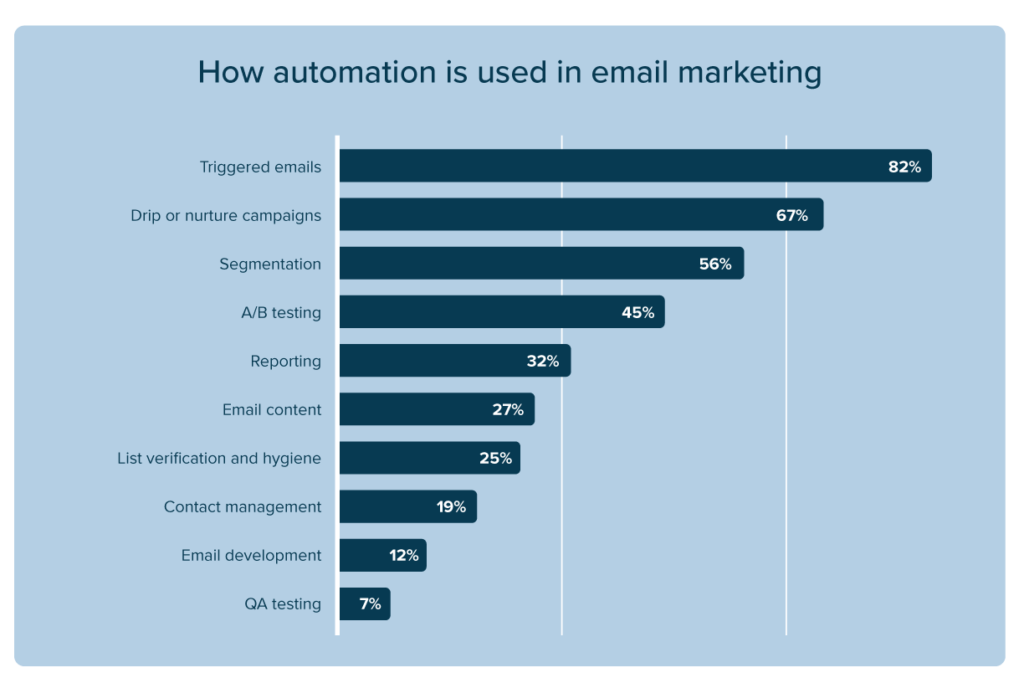
4.2 Routine Tasks, Meet Your Match
AI steps in to handle the nitty-gritty tasks that once demanded hours of manual labor.
From segmenting your audience based on behavior to scheduling emails at optimal times, AI automation takes care of it all.
No more manual sorting or late-night email scheduling sessions – AI’s got it covered.
4.3 Impact on Efficiency
Let’s talk about efficiency, the heartbeat of successful marketing endeavors. AI doesn’t just speed up processes; it supercharges them. Here’s how:
a. Time Management Mastery
No more drowning in the minutiae. AI automates routine tasks, freeing up your time to focus on strategy, creativity, and crafting compelling content.
Schedule emails, analyze data, and tweak campaigns – all without lifting a finger. Well, maybe just one to click “Activate Automation.”
b. Resource Allocation Revolution
Allocate your resources strategically. With automation handling repetitive tasks, your team can redirect their efforts toward high-impact activities that truly move the needle.
Whether it’s fine-tuning your targeting strategy or experimenting with innovative campaign ideas, automation ensures resources are invested where they matter most.
c. The Domino Effect on Results
Efficiency isn’t just about saving time; it’s about amplifying results. AI-driven automation ensures that every action is intentional, every email is strategically timed, and every campaign aligns with your overarching goals.
4.4 Adapting to User Behavior
AI doesn’t just automate; it adapts. It learns from user behavior, adjusting the automation flow based on how subscribers engage with your emails.
It’s a dynamic dance where the steps change in real-time, ensuring your audience receives content tailored to their journey.
5. Predictive Analytics
As we move forward in our AI-powered exploration, the spotlight will shift to Predictive Analytics, where AI’s ability to forecast user behavior becomes a game-changer.
Brace yourselves for more revelations in our journey through the realms of efficiency and marketing prowess!
5.1 Cracking the Crystal Ball: AI-Driven Predictive Analytics
Imagine having the ability to peek into the future, foreseeing how your audience will engage with your emails.
That’s the magic of AI-driven predictive analytics.
It’s not about gazing into a crystal ball but analyzing vast data landscapes to uncover patterns and predict the next moves of your audience.
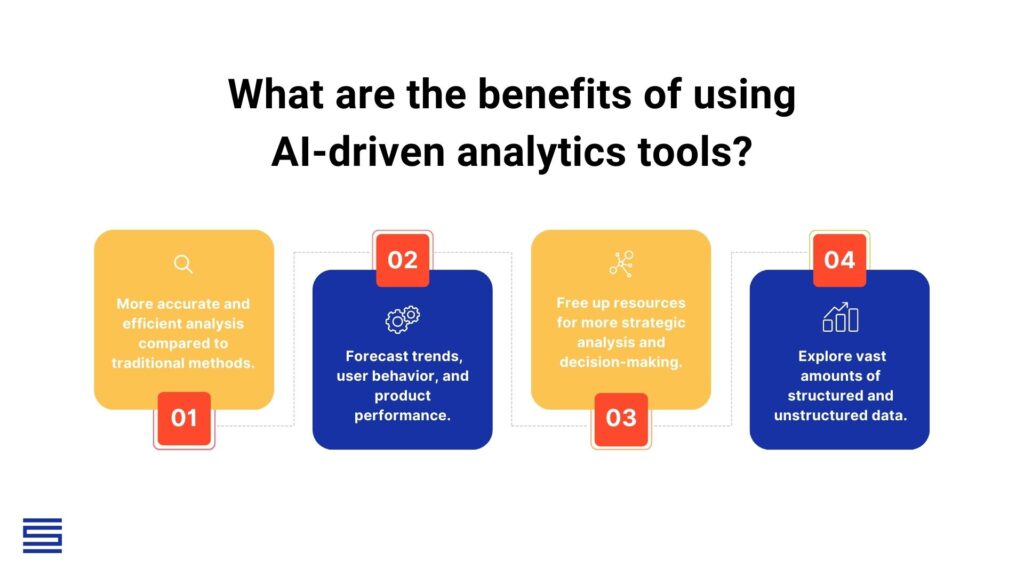
5.2 The Forecasting Feast: AI’s Role in Predictive Analytics
- Understanding Past Patterns: AI delves into historical data, examining how subscribers have interacted with previous campaigns. It deciphers patterns and trends, unraveling the intricacies of user behavior.
- Behavioral Analysis: AI doesn’t just stop at past behavior; it dissects real-time actions. By understanding how users currently engage with your emails, it refines its predictions, creating a dynamic, ever-evolving model.
- Anticipating Future Actions: Armed with historical and real-time insights, AI predicts future actions. Will a subscriber open that email? Click on that link? Make a purchase? The answers lie in the predictive algorithms humming quietly in the background.
5.3 Optimizing Timing for Maximum Impact
Timing is everything, and AI knows it.
Predictive analytics doesn’t just forecast what users will do; it pinpoints when they’re most likely to do it.
AI optimizes the timing of your email campaigns, ensuring they hit the inbox at the precise moment when your audience is primed for engagement.
- Peak Engagement Windows: AI identifies the windows when your audience is most active, ensuring your emails don’t get lost in the digital noise.
- Time Zone Mastery: Catering to a global audience? No problem. AI considers time zones, delivering emails at times that resonate with each segment of your audience.
5.4 Crafting Content that Speaks to the Future
It’s not just about when; it’s also about what. AI-driven predictive analytics influences the content of your emails, ensuring they align with the forecasted needs and preferences of your audience.
- Personalized Recommendations: AI suggests products or content based on what it predicts the subscriber will find most appealing.
- Tailored Messaging: Whether it’s a special offer, a personalized message, or relevant content, AI tailors the email to align with predicted user behavior.
6. Improved Customer Experience
Brace yourselves for a journey where AI, donning the cape of personalization and innovation, elevates customer interactions to a whole new level.
6.1 AI’s Symphony of Enhanced Customer Experience
In the realm of email marketing, customer experience isn’t just a buzzword; it’s the essence of meaningful connections. AI emerges as the virtuoso, orchestrating a symphony that resonates with each subscriber, enhancing satisfaction and loyalty.
6.2 Chatbots: The Digital Concierges
Imagine having a round-the-clock assistant ready to engage with your customers, answering queries, and providing assistance – that’s the magic of chatbots. AI-powered chatbots bring a conversational flair to your emails, fostering real-time interactions.
- Instant Engagement: Chatbots engage with users instantly, offering immediate responses to inquiries or guiding them through the customer journey.
- Personalized Conversations: AI analyzes user data to tailor chatbot interactions. It’s not just about providing information; it’s about understanding the individual and delivering responses that resonate.
- Lead Nurturing: Chatbots play a pivotal role in lead nurturing, guiding prospects through the sales funnel with personalized recommendations and information.
6.3 Virtual Assistants: Your 24/7 Support System
AI doesn’t confine itself to emails; it extends its reach through virtual assistants that seamlessly integrate with your customer support ecosystem.
- Efficient Query Resolution: Virtual assistants efficiently handle routine customer queries, freeing up human support agents for more complex issues.
- Consistent Brand Voice: AI ensures a consistent brand voice in all interactions, maintaining a cohesive and recognizable experience across channels.
- Data-Driven Insights: Virtual assistants leverage data analytics to gain insights into customer preferences and behavior, contributing to a deeper understanding of the audience.
6.4 AI-Driven Customer Support: Unleashing the Support Superpowers
When it comes to customer support, AI-driven solutions amplify efficiency and satisfaction.
- Quick Issue Resolution: AI analyzes past customer interactions to predict and resolve issues swiftly, minimizing response times and maximizing customer satisfaction.
- Personalized Support: By understanding individual customer profiles, AI tailors support interactions, ensuring that responses align with the customer’s history and preferences.
- Proactive Engagement: AI anticipates potential issues, reaching out to customers before problems escalate. It’s a proactive approach that prevents dissatisfaction and fosters a positive experience.
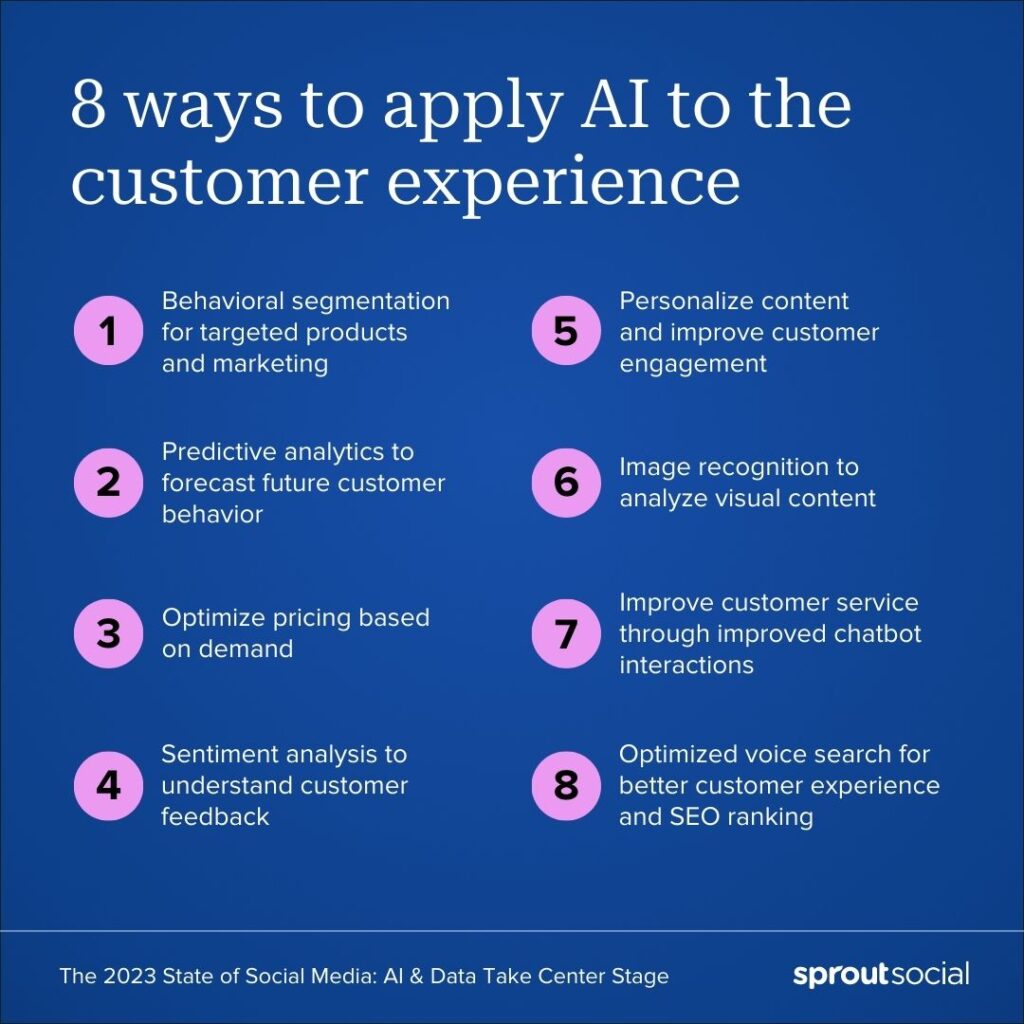
As we embrace this proactive era of customer engagement, the journey toward a more responsive and customer-centric future is both promising and exciting.
7. Challenges and Ethical Considerations
Navigating the transformative landscape of AI in email marketing isn’t without its hurdles. As we embrace innovation, it’s crucial to shine a light on the challenges and ethical considerations inherent in this dynamic terrain.
7.1 Challenges in the AI-Infused Landscape
- Over-Reliance on Automation: While AI automates tasks efficiently, there’s a risk of over-reliance. Marketers must strike a balance, ensuring that human creativity and strategic thinking remain integral to campaign development.
- Data Quality and Bias: AI’s effectiveness heavily relies on data quality. Biases in data, whether historical or unintentional, can lead to skewed predictions and potentially alienate certain segments of the audience.
- Algorithmic Complexity: The intricacies of AI algorithms can be challenging to decipher. Marketers may find it daunting to fully understand the decision-making processes behind AI-driven recommendations and actions.
7.2 Ethical Considerations and Privacy Issues
- Respecting Privacy Boundaries: Collecting and analyzing user data for personalization must be done transparently and with explicit consent. Respecting privacy boundaries is paramount to maintaining trust with your audience.
- Informed Consent: Users should be informed about the use of AI in email marketing and have the ability to opt in or out of personalized features. Transparency builds trust and ensures ethical practices.
- Data Security: Safeguarding user data from breaches or unauthorized access is crucial. Implementing robust security measures is not only an ethical responsibility but also a legal requirement.
7.3 The Imperative of Responsible AI Usage
- Continual Monitoring and Adjustment: Marketers need to continually monitor AI algorithms, identifying and rectifying biases or inaccuracies. This ongoing commitment to improvement ensures responsible AI usage.
- Education and Awareness: Both marketers and users should be educated about AI capabilities and limitations. Transparent communication helps set realistic expectations and mitigates potential concerns.
- Regulatory Compliance: Staying abreast of and complying with evolving data protection regulations is non-negotiable. Adhering to legal frameworks ensures that AI usage aligns with ethical and legal standards.
In addressing these challenges and ethical considerations, marketers can harness the power of AI responsibly, fostering a digital landscape that prioritizes transparency, user consent, and the ethical treatment of data.
In Conclusion
Our exploration into AI In Email Marketing Campaigns has unveiled a landscape where innovation and data-driven strategies converge to redefine the very essence of customer engagement.
From the evolution of email marketing’s humble beginnings to the infusion of Artificial Intelligence (AI) as the driving force, our journey has been marked by transformative insights and revelations.
As we embrace the future of email marketing infused with AI, let us tread with a balance of innovation and ethical mindfulness.
This journey is not just about optimizing campaigns; it’s about creating meaningful connections, building trust, and fostering a digital landscape that respects technological advancement and human values.

